1998 CHEVROLET PRIZM change time
[x] Cancel search: change timePage 183 of 364
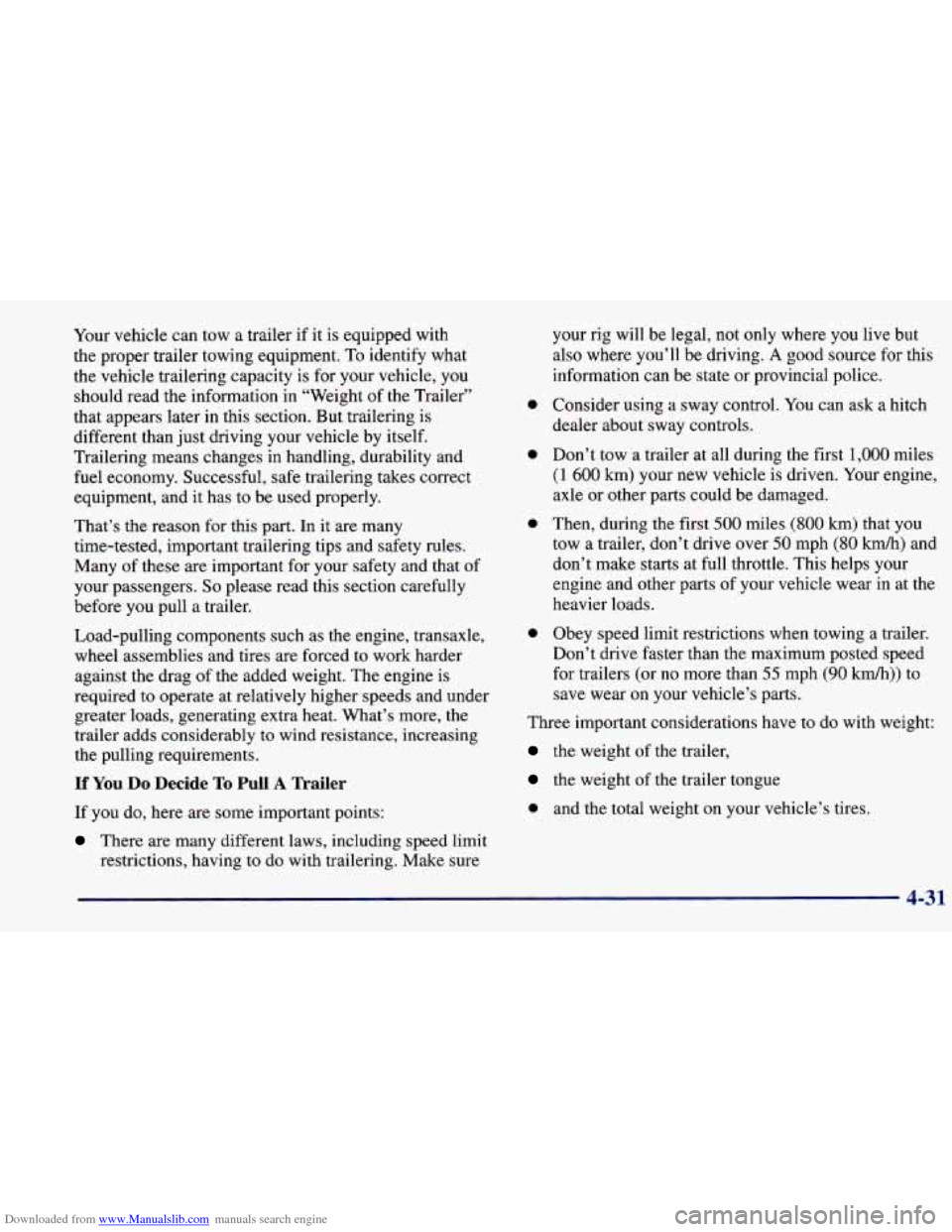
Downloaded from www.Manualslib.com manuals search engine Your vehicle can tow a trailer if it is equipped with
the proper trailer towing equipment. To identify what
the vehicle trailering capacity
is for your vehicle, you
should read the information in “Weight of the Trailer”
that appears later in this section. But trailering is
different than just driving your vehicle by itself.
Trailering means changes in handling, durability and
fuel economy. Successful, safe trailering takes correct equipment, and it has to be used properly.
That’s the reason for this part. In it are many
time-tested, important trailering tips and safety rules.
Many of these are important for your safety and that of
your passengers.
So please read this section carefully
before you pull a trailer.
Load-pulling components such as the engine, transaxle, wheel assemblies and tires are forced to work harder
against the drag
of the added weight. The engine is
required to operate at relatively higher speeds and under
greater loads, generating extra heat. What’s more, the
trailer adds considerably to wind resistance, increasing
the pulling requirements.
If You Do Decide To Pull A Trailer
If you do, here are some important points:
There are many different laws, including speed limit
restrictions, having to do with trailering. Make sure
0
0
0
0
your rig will be legal, not only where you live but
also where you’ll be driving.
A good source for this
information
can be state or provincial police.
Consider using a sway control. You can ask
a hitch
dealer about sway controls.
Don’t tow a trailer at all during the first
1,000 miles
(1 600 km) your new vehicle is driven. Your engine,
axle or other parts could be damaged.
Then, during the first
500 miles (800 km) that you
tow a trailer, don’t drive over 50 mph (80 km/h) and
don’t make starts at
full throttle. This helps your
engine and other parts of your vehicle wear in at the
heavier loads.
Obey speed limit restrictions when towing a trailer.
Don’t drive faster than the maximum posted speed
for trailers (or no more than
55 mph (90 km/h)) to
save wear on your vehicle’s parts.
Three important considerations have to do with weight:
the weight of the trailer,
the weight of the trailer tongue
0 and the total weight on your vehicle’s tires.
Page 220 of 364
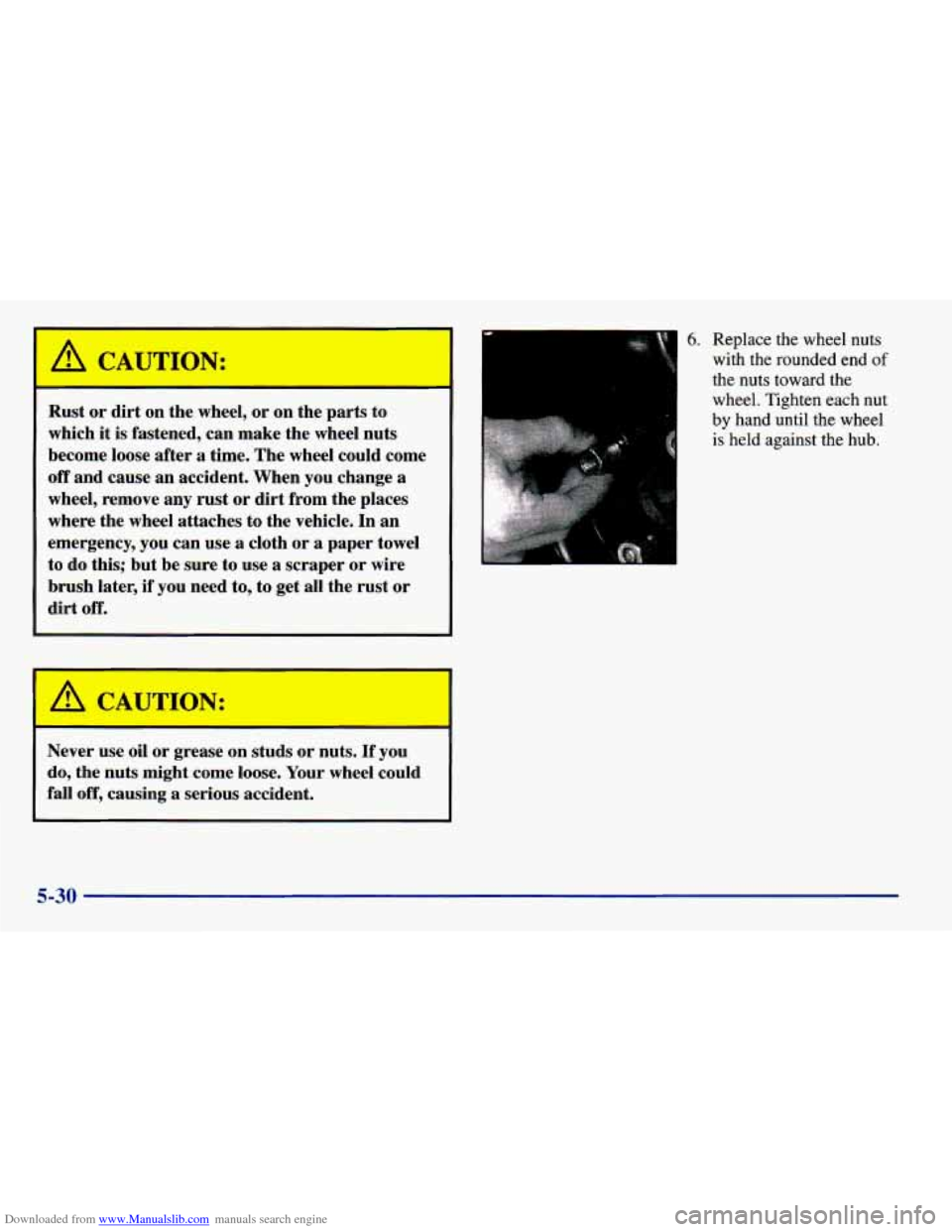
Downloaded from www.Manualslib.com manuals search engine A CAUTION:
Rust or dirt on the wheel, or on the parts to
which
it is fastened, can make the wheel nuts
become loose after
a time. The wheel could come
off and cause an accident. When you change a
wheel, remove any rust or dirt from the places
where the wheel attaches to the vehicle. In an
emergency, you can use
a cloth or a paper towel
to do this; but be sure to use a scraper or wire
brush later,
if you need to, to get all the rust or
dirt
off.
Never use oil or grease on studs or nuts. If you
do, the nuts might come loose. Your wheel could
fall
off, causing a serious accident.
6. Replace the wheel nuts
with the rounded end
of
the nuts toward the
wheel. Tighten each
nut
by hand until the wheel
is held against the hub.
5-30
Page 244 of 364
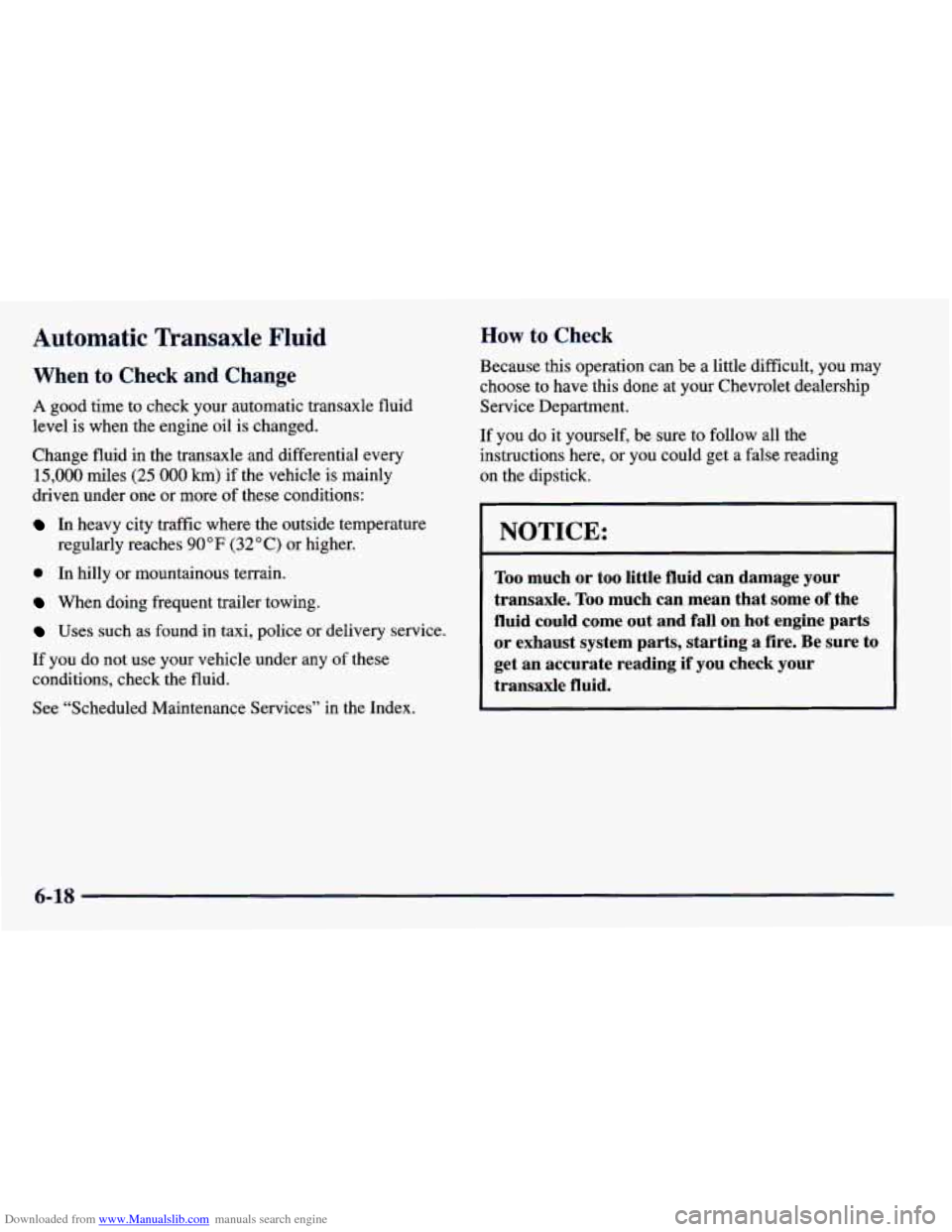
Downloaded from www.Manualslib.com manuals search engine Automatic Transaxle Fluid
When to Check and Change
A good time to check your automatic transaxle fluid
level is when the engine oil is changed.
Change fluid in the transaxle and differential every
15,000 miles (25 000 km) if the vehicle is mainly
driven under one or more of these conditions:
In heavy city traffic where the outside temperature
regularly reaches
90°F (32°C) or higher.
0 In hilly or mountainous terrain.
When doing frequent trailer towing.
Uses such as found in taxi, police or delivery service.
If you do not use your vehicle under any of these
conditions, check the fluid.
See “Scheduled Maintenance Services’’ in the Index.
How to Check
Because this operation can be a little difficult, you may choose
to have this done at your Chevrolet dealership
Service Department.
If you do it yourself, be sure to follow all the
instructions here, or you could get a false reading
on the dipstick.
I NOTICE:
Too much or too little fluid can damage your
transaxle.
Too much can mean that some of the
fluid could come out and fall on hot engine parts
or exhaust system parts, starting a fire. Be sure to
get an accurate reading if you check your
transaxle fluid.
6-18 .-
Page 247 of 364
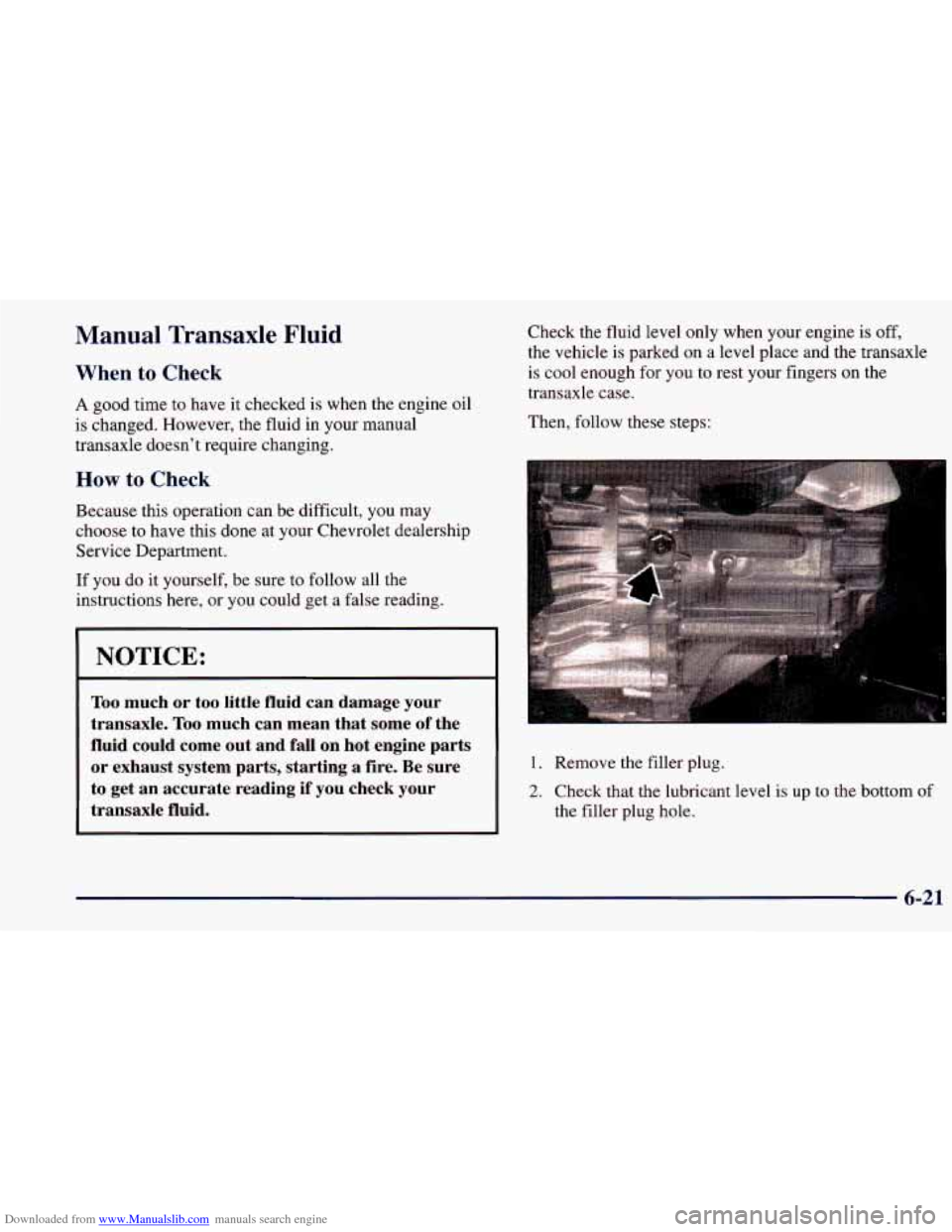
Downloaded from www.Manualslib.com manuals search engine Manual Transaxle Fluid
When to Check
A good time to have it checked is when the engine oil
is changed. However, the fluid
in your manual
transaxle doesn’t require changing.
How to Check
Because this operation can be difficult, you may
choose to have this done at your Chevrolet dealership
Service Department.
If you do it yourself, be sure to follow all the
instructions here, or you could get a false reading.
I NOTICE:
Too much or too little fluid can damage your
transaxle.
Too much can mean that some of the
fluid could come out and fall on hot engine parts
or exhaust system parts, starting a
fire. Be sure
to get an accurate reading if you check your
transaxle fluid.
Check the fluid level only when your engine is off,
the vehicle is parked on a level place and the transaxle
is cool enough for
you to rest your fingers on the
transaxle case.
Then, follow these steps:
1. Remove the filler plug.
2. Check that the lubricant level is up to the bottom of
the filler plug hole.
6-21
Page 258 of 364
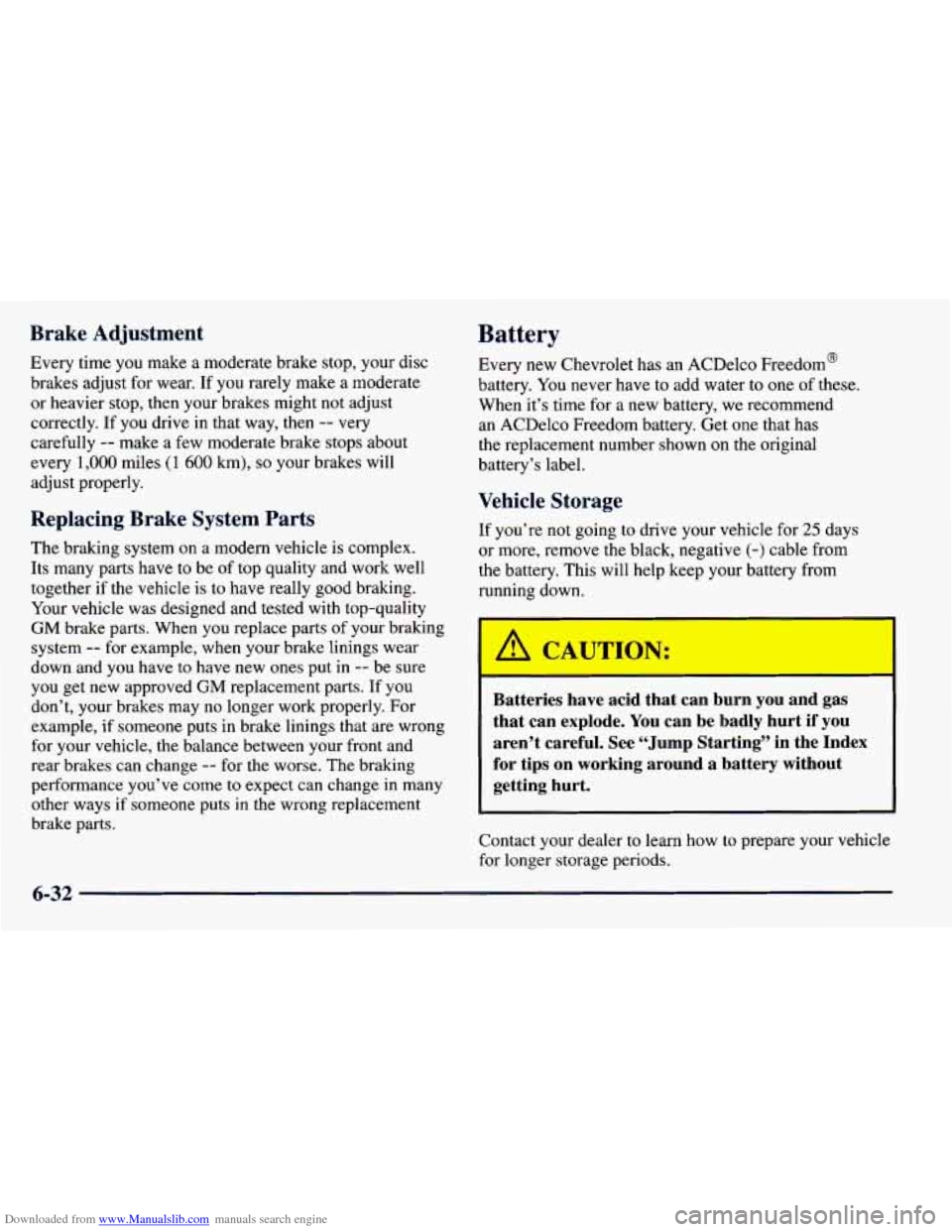
Downloaded from www.Manualslib.com manuals search engine Brake Adjustment
Every time you make a moderate brake stop, your disc
brakes adjust for wear. If you rarely make a moderate
or heavier stop, then your brakes might not adjust
correctly. If you drive in that way, then
-- very
carefully
-- make a few moderate brake stops about
every
1,000 miles (1 600 km), so your brakes will
adjust properly.
Replacing Brake System Parts
The braking system on a modern vehicle is complex.
Its many parts have to be of top quality and work well
together
if the vehicle is to have really good braking.
Your vehicle was designed and tested with top-quality
GM brake parts. When you replace parts of your braking
system
-- for example, when your brake linings wear
down and you have to have new ones put in
-- be sure
you get new approved
GM replacement parts. If you
don’t, your brakes may no longer work properly. For
example, if someone puts in brake linings that are wrong
for your vehicle, the balance between your front and
rear brakes can change
-- for the worse. The braking
performance you’ve come to expect can change
in many
other ways if someone puts in the wrong replacement
brake parts.
Battery
Every new Chevrolet has an ACDelco Freedom@
battery.
You never have to add water to one of these.
When it’s time for a new battery, we recommend
an ACDelco Freedom battery. Get one that has
the replacement number shown on the original
battery’s label.
Vehicle Storage
If you’re not going to drive your vehicle for 25 days
or more, remove the black, negative
(-) cable from
the battery. This will help keep your battery from
running down.
Batteries have acid that can burn you and gas
that can explode.
You can be badly hurt if you
aren’t careful. See
“Jump Starting’’ in the Index
for tips on working around a battery without
getting hurt.
1
Contact your dealer to learn how to prepare your vehicle
for longer storage periods.
6-32
Page 265 of 364

Downloaded from www.Manualslib.com manuals search engine Tire Inspection and Rotation
Tires should be rotated every 6,000 to 8,000 miles
(10 000 to 13 000 km). Any time you notice unusual
wear, rotate your tires as soon as possible and check
wheel alignment. Also check for damaged tires or
wheels. See “When It’s Time for New Tires” and
“Wheel Replacement” later in this section for
more information.
The purpose of regular rotation is to achieve more
uniform wear for all tires on the vehicle. The first
rotation is the most important. See “Scheduled
Maintenance Services” in the Index for scheduled
rotation intervals. Don’t include the compact spare tire
in your
tire rotation.
After the tires have been rotated, adjust the front
and rear inflation pressures as shown on the
Tire-Loading Information label. Make certain that
all wheel nuts are properly tightened. See “Wheel
Nut Torque” in the Index.
When rotating your tires, always
use the correct rotation
pattern shown here.
-
A CA u T1GI.C:
Rust or dirt on a wheel, or on the parts to which
it is fastened, can make wheel nuts become loose
after
a time. The wheel could come off and cause
an accident. When you change
a wheel, remove
any rust or dirt from places where the wheel
attaches to the vehicle. In an emergency, you can
use
a cloth or a paper towel to do this; but be
sure to use a scraper or wire brush later, if you
need to, to get all the rust or
dirt off. (See
“Changing
a Flat Tire” in the Index.)
I
6-39
Page 342 of 364

Downloaded from www.Manualslib.com manuals search engine Courtesy Transportation
Chevrolet offers Courtesy Transportation for customers needing warranty service. Courtesy Transportation will
be offered in conjunction with the coverage provided by
the Bumper to Bumper New Vehicle Limited Warranty
to retail purchasers of 1998 Chevrolet passenger cars
and light duty trucks (please see your selling dealer
for details).
Courtesy Transportation includes:
0
0
0
0
One way shuttle ride for any warranty repair
completed during the same day.
Up to $30 maximum daily vehicle rental allowance
for any overnight warranty repair up to five days,
OR
Up to $30 maximum daily cab, bus or other
transportation allowance in lieu of rental for any
overnight warranty repair up to five days,
OR
Up to $10 daily fuel allowance.for rides provided by
another person (i.e., friend, neighbor, etc.)
in lieu of
rental for
any overnight warranty repair up to five days.
Note: All Courtesy Transportation arrangements will be administered by your Chevrolet dealer
service management. Claim amounts should
reflect all actual costs.
0 Chevrolet Courtesy Transportation is not part of the
Bumper to Bumper New Vehicle Limited Warranty.
Chevrolet reserves the right to make any changes
or
discontinue Courtesy Transportation at any time without notification.
0 For additional program details, contact your
Some state insurance regulations make it impractical to
rent vehicles to people under 21 years of age.
If you are
under 21 and have difficulty renting a vehicle, Chevrolet
will reimburse up to $30/day for documented
transportation you receive.
For warranty repairs during the Complete Vehicle Coverage period in the New Vehicle Limited Warranty,
interim transportation may be available under the
Courtesy Transportation Program. Please consult your
dealer for details. The Roadside Assistance program is
available only in the United States and Canada.
In Canada, please consult your GM dealer for
information on Courtesy Transportation. Chevrolet dealer.
8-8
Page 347 of 364

Downloaded from www.Manualslib.com manuals search engine NOTE: Dealers and Companies please provide dealer or company name, an\
d also the
name of the person to whose attention the shipment should be sent.
Mail completed order form
to:
For purchases outside U.S.A. please write to the above address for quotation.
HELM, INCORPORATED P.O. Box 07130 Detroit, MI 48207
(CUSTOMER’S NAME)
(ATTENTION)
(STREET ADDRESS-NO P.O. BOX NUMBERS)
(CITY) (STATE)
(ZIP CODE)
DAYTIME TELEPHONE NO. 0
GM-CHE-ORDSB *(Prices are subject to change without notice and without incurring
obligation. Allow ample time for delivery.) Check here
if your
billing address
Date mo/yr
I -1 I
CUSTOMER SIGNATURE I
Note to Canadian Customers: All listed prices are quoted in U.S. funds. Canadian residents
are to make checks payable in US. funds. To cover Canadian postage, add $11 50 plus the US. order processing.